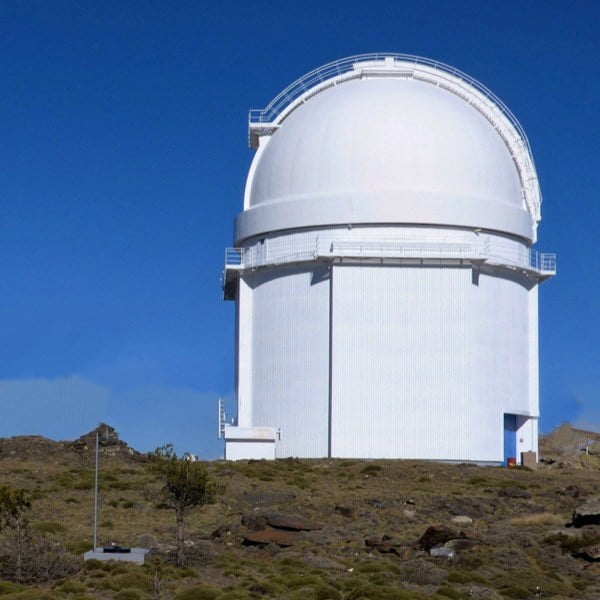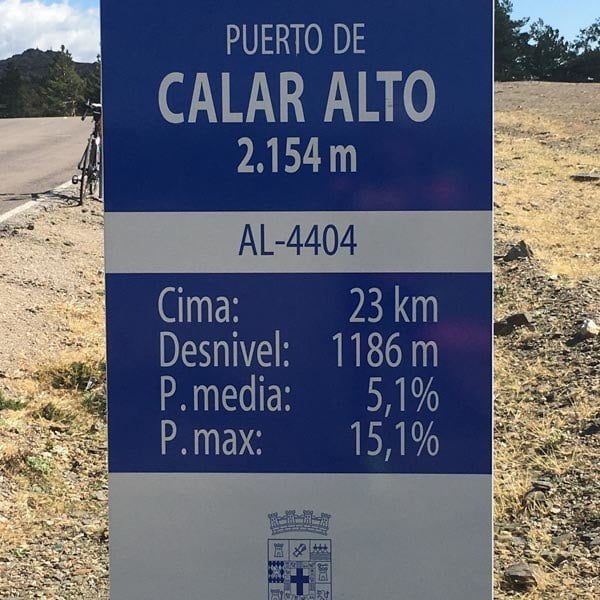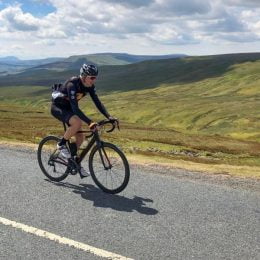From the moment we saw the Calar Alto cycling climb, when watching the 2017 Vuelta, there was something about it that made us want to go and experience it first hand – something about the remoteness at the summit, the length of the climb and the fact that you don’t always get the chance to go higher than 2,000 metres.
To be honest, in terms of looks alone, the ride up is relatively unspectacular as climbs go (especially when compared to the Velefique). You may be going over 2,000m but don’t expect Alpine-style peaks around you – it’s barren in a wild, scrubby sort of a way.
But what it lacks in sparkle it gains as a sheer endurance test.
Grinding your way through the forest for kilometre after kilometre tests the mental strength as well as the legs, which suffer from long sections at around 7%.
It’s all worth it of course at the top when you are greeted by the most surreal sight of all – half a dozen or so huge white structures housing telescopes. You’ve arrived at the famous Calar Alto observatory.
All metrics in this article are approximate.
Highlights
The challenge of a 30 km ascent made famous by the Vuelta a España.
It’s not often that you get the opportunity to test yourself on such a long climb. It’s a slog, but there’s a massive sense of achievement when you finally arrive at the summit.
 View of Tetice de Bacaras, where you might come from if you were to do a mammoth route of Velefique and Calar Alto in one day!
View of Tetice de Bacaras, where you might come from if you were to do a mammoth route of Velefique and Calar Alto in one day! Observatory at Calar Alto
Observatory at Calar Alto Summit sign
Summit signRoute notes
1. Gérgal to Calar Alto Observatory (0 to 36 km)
Initially we cycled parallel to the A92 on the service road for about 5 km until we reached the AL 4044 and then leaving the Desierto de Tabernas behind us we headed due north. It is worth noting that there is a petrol station on the A92 should you want an extra bottle or two for the climb, as you are now heading into pretty remote territory.
The road surface is in good order and the climb (average gradient of 4.6%) is furnished with distance markers at each kilometre indicating your progress and the gradient for the next kilometre. It is a long hard slog especially when it’s hot and the only real sign of life is at the tiny village of Aulago, which you reach about 8 km into the climb.
The main thrust of the climb takes you through wooded areas with occasional views back into the valley below. As the trees thin out and the vegetation starts to disappear at around 2,000 metres you start to feel a slight chill in the air – the signal to click into a higher gear (if you can!) and increase the watts to keep warm as the average gradient in the last half a dozen kilometres begins to ease.
You are now approaching the highest point in the province of Almeria.
The trees and roadside vegetation disappear but what awaits you at the top is quite surreal – half a dozen absolutely massive white domes that look back out over the province of Almeria and beyond. It’s unlike anything you have seen before, akin to landing on a far flung planet. It’s quite eerie in some respects as there is no cafe or tourist centre and nothing to do other than take a few photographs. The only other life we saw up there were around a dozen cyclists – including a group of five who had made the trip from Australia!
2. Calar Alto Observatory to Gérgal (37 to 58 km)
Push on across the top of the ridge for around three to four kilometres and, instead of turning left towards Bacares (and eventually the Alto de Velefique) at the A1178, head south, with the desert on the left hand side of the road.
It’s a fast descent all the way back into Gérgal. As you start the descent, the views to your left are amazing.
We’ve no idea how far we could see in terms of distance, but it seemed we could see the whole of Andalusia as we powered back through the forest and down towards the desert.
It doesn’t get much better on a bike than descending at speed on quiet roads – as you know, the feeling is difficult to put into words! On similar descents elsewhere in Europe, you seem to have to periodically brake for a car, or a motorcycle or a group of cyclists and lose your momentum. In this part of the world we found we only had to brake on the bends!
It was a totally exhilarating 20 km run and over far too quickly as we sped back to Gérgal and enjoyed a cerveza.
Café stops
Restaurants are few and far between in this remote part of the world. However there are a couple to choose from in Gérgal, and there’s also the petrol station near the start of the ride, so make sure you’re fed and watered before you head up the climb.
Accommodation
We drove to the start of this loop from our base in Mojácar, a 1 hour 15 minutes drive. This really isn’t a very touristy part of the world, so if you want somewhere nice to stay, you need to base yourself on/near the coast. Our ultimate guide to cycling Almeria has details of where we stayed.
Tips
Read our tips for cycling in Almeria before you set out.
Click here for our complete guide to planning a cycling trip to Almeria.
At the top of Calar Alto is an astronomical observatory situated at 2,168 metres above sea level. It boasts the largest telescope in mainland Europe and is famously characterised by a number of huge white dome shaped buildings which house the various telescopes. You can vaguely see them some 30 km away down in the valley as you start the climb near Gérgal, but close up their size is quite intimidating.
At over 2,000m at the summit, you’ll want to have a jacket and possibly gloves for the descent.
Watch out for goats!
Take enough water with you; once you have passed Aulago, there is nowhere to fill your bottles on the climb up.
Calar Alto can also be accessed in a reverse counterclockwise loop from our starting point at Gergal. The length of the ascent to the observatory in this direction is shorter at 23 km but at a higher average gradient of 6.1%. We opted for the longer ascent passed the village of Aulago of 30 km at a gradient of 4.6%. The climb represents a stiff test whichever route you choose.
Alternatively you can get there by ascending the Alto Velefique then dropping down into the village of Bacares before turning south and then west as you climb to the summit of the Observatorio Astronómico de Calar Alto.
Please support Epic Road Rides
A huge amount of time and effort goes into the article you’ve just read, all with the aim of helping you!
If you found what you’ve read useful, I’d really appreciate it if you dropped something in the tip jar here.
It’s a way you can say thank you and help us carry on creating top quality content with no annoying ads and no pay wall.
Looking for an organised cycling trip?
If you want someone to help you plan and book your cycling holiday, fill out this form. We aren’t a tour operator/agent but we work with lots of people who are and will do our best to put you in touch with someone that can help (within 24 hours wherever possible)!
The contents of this website are provided for general information purposes only. It is not intended to amount to advice and you should not rely on it. You should carry out your own due diligence and take professional advice. We make no representations, warranties or guarantees, whether express or implied, that the content on our website is accurate, complete or up to date. If you use any information or content on this website, download from, or otherwise obtain content or services through our website, it is entirely at your own discretion and risk. Epic Road Rides Ltd disclaims all liability and responsibility arising from any reliance placed on the information and content on this website. Find out more here.


Hi, on Strava, the road is not pave roads for all the loop. Is it 100% pave roads ? Or do we need gravel bikes?
We did it on road bikes…
We would love to see some pics of your ascent etc. Just to give your very good description some context.
Hi Nick, agree, this route is a bit light on photos, sorry! As and when we go back will remember to get some more!